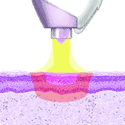 Portrait® PSR3
Portrait® PSR3

The Science of PSR
From superficial epidermal to deeper dermal treatment, Portrait ® PSR³ yields the therapeutic results patients and physicians desire with an optimized recovery profile.
- Low morbidity, erythema and recovery time
- Continuing regenerative process producing sustainable improvements in photodamage
- Progressive replacement of old thermally modified architecture by new architecture
- Regenerated reticular architecture of the upper dermis and DE junction
- Fibroblasts from deeper dermis migrate to support improvement of skin's architecture and surface
- Restoration of more normal mechanical and physiological functions of the dermis

Plasma Pulse from Portrait® PSR3 Handpiece
Unique thermal profile distinguishes new plasma technology
- Non-contact millisecond pulses of nitrogen plasma energy
- Non-chromophore dependent energy absorption
- Uniform, predictable, non-disruptive impact
- Unique skin surface microenvironment
- Epidermis and stratum corneum intact at time of treatment
- No wound created, epidermal vaporization or charring
- Intact epithelium immediately post treatment protects and speeds healing
- Conduction of thermal energy into dermis
- Vacuolation of epidermis acts as insulator at high energy
- Easy to feather treatment areas
- No scarring or hypopigmentation in clinical studies to date
Portrait® PSR3 Zone of Effect
Clinical Roundtable: Researchers Unveil Portrait PSR Study Results , Kronemyer, Bob (featuring Drs. Richard Fitzpatrick, Eric Bernstein, Suzanne Kilmer, Ronald Moy). Aesthetic Buyers Guide; Mar/Apr 2005
Plasma Skin Regeneration Provides Unique Treatment Spectrum , Kronemyer, Bob (featuring Drs. Richard Fitzpatrick, Eric Bernstein, Suzanne Kilmer, Ronald Moy, Jean-Francois Tremblay, Roy Geronemus). Aesthetic Buyers Guide; Nov/Dec 2004
PSR Technology Creates Unique Surface Microenvironment for Skin Regeneration Kronemyer, Bob (featuring Richard Fitzpatrick, MD). Aesthetic Buyers Guide; February 2005.



